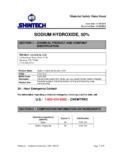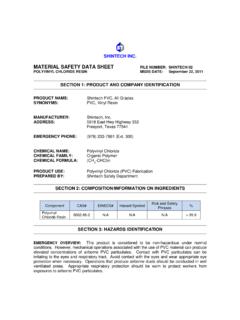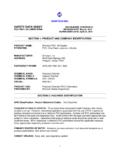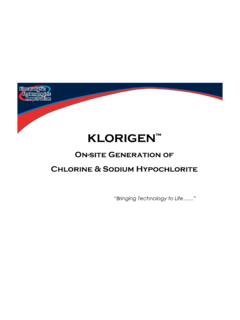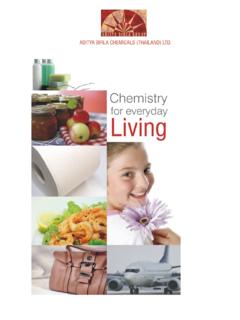Transcription of SODIUM Reviewed Date: 01/08/2016 HYDROXIDE, 50% - …
1 SAFETY DATA SHEET SODIUM hydroxide , 50% Issue date : 01/10/2011 Reviewed date : 01/08/2016 Page 1 of 16 SECTION 1 CHEMICAL PRODUCT AND COMPANY IDENTIFICATION Manufacturer: Shintech Louisiana, LLC 3 Greenway Plaza, Suite 1150 Houston, TX 77046 (713) 965-0713 PRODUCT NAME: SODIUM hydroxide Solution, 50% CAS#: 1310-73-2 CHEMICAL FOMULA: NaOH(50) Synonyms Caustic Soda Liquid 50%, Soda Lye, Lye, Liquid Caustic, SODIUM Hydrate Product Use: Neutralizing agent, industrial cleaner, pulping and bleaching, soap manufacturing For information regarding a chemical emergency involving a spill or leak, call: 24 Hour Emergency Contact: : 1-800-424-9300 CHEMTREC SECTION 2 HAZARDS IDENTIFICATION Global Harmonization System (GHS) Classification: Category 1 Skin corrosion/irritation - Category 1 Serious eye damage/eye irritation Category 1 Specific target organ toxicity - Single exposure Category 3 Chronic toxicity to the aquatic environment SAFETY DATA SHEET SODIUM hydroxide , 50% Issue date : 01/10/2011 Reviewed date : 01/08/2016 Page 2 of 16 National Fire Protection Association (NFPA) Rating Hazardous Materials Identification Systems (HMIS) Rating NFPA HMIS Health 3 3 4 = Extreme/Severe W Water Reactive Fire 0 0 3 = High/Serious Reactivity 1 1 2 = Moderate 1 = Slight 0 = Minimum DANGER!
2 Causes severe eye burns. Causes severe skin burns. Avoid contact with skin and eyes. Causes burns of the mouth and throat. Causes respiratory tract irritation. Avoid breathing vapors or mist. Aspiration hazard. Can enter lungs and cause damage. May react with water. Keep upwind of spill and use in adequate ventilation. Emergency Overview: Color: Colorless Odor: Odorless Physical State Liquid above freezing point Signal Word DANGER GHS Label Elements: GHS Hazard Statements: Causes serious eye damage Causes severe skin burns and eye damage Harmful if swallowed Causes damage to respiratory system by inhalation May cause allergy or asthma symptoms or breathing difficulties if inhaled May be corrosive to metals SAFETY DATA SHEET SODIUM hydroxide , 50% Issue date : 01/10/2011 Reviewed date : 01/08/2016 Page 3 of 16 GHS Precautionary Statements: Storage: Keep container closed.
3 Keep in original container. Store in a secure manner. Ventilation Controls: Do not breathe (dust, vapor or spray mist). Hygiene Measures: When using, do not smoke, eat, or drink. Wash thoroughly after handling. Avoid contact with skin and eyes. Personal Protective Equipment: Wear suitable protective clothing, gloves, and eye/face protection. Spills: NEVER direct water jet on liquid. Dike the area to contain the spill. Collect in suitable and properly labeled containers. Attempt to neutralize by adding material such as Acetic acid. First Aid (See Section 4): In case of accident by inhalation, move person to fresh air. If swallowed, do not induce vomiting: seek medical advice immediately and show label to doctor. After contact with skin, immediately take off all contaminated clothing and wash immediately with plenty of water.
4 In case of contact with eyes, rinse immediately with plenty of water. In all cases, if irritation develops and persists, get medical attention. In all cases, call a poison control center or doctor for further treatment advice. Environmental Protection: Use appropriate containment to avoid environmental contamination. Disposal: Dispose of contents and container in accordance with applicable local, regional, national, and/or international regulations. SAFETY DATA SHEET SODIUM hydroxide , 50% Issue date : 01/10/2011 Reviewed date : 01/08/2016 Page 4 of 16 POTENTIAL HEALTH EFFECTS: EYE CONTACT May cause severe irritation with corneal injury which may result in permanent impairment of vision, even blindness. Chemical burns may occur.
5 Mist may cause eye irritation. Short Term Exposure Long Term Exposure: SKIN CONTACT Brief contact may cause severe skin burns. Symptoms may include pain, severe local redness and tissue damage. SKIN ABSORPTION Prolonged skin contact is unlikely to result in absorption of harmful amounts. INHALATION: Mist may cause severe irritation of upper respiratory tract (nose and throat). May cause chemical burns to the respiratory tract. INGESTION Swallowing may result in burns of the mouth and throat. Swallowing may result in gastrointestinal irritation, ulceration, nausea and/or vomiting. Aspiration into the lungs may occur during ingestion or vomiting, causing tissue damage or lung injury.
6 CONDITIONS AGGRAVATED BY EXPOSURE Respiratory disorders, pre-existing skin disorders, eye/vision disorders. TARGET ORGANS EFFECTED: Skin, Eyes, Respiratory System. SECTION 3 COMPOSITION/INFORMATION ON INGREDIENTS Hazardous ingredients (specific) Typical % CAS Number EC Number Water 50 7732-18-5 7732-18-5 SODIUM hydroxide 50 1310-73-2 7732-18-5 SODIUM Chloride < 1 7647-14-5 231-598-3 Common Caustic Soda Liquid 50%, Soda Lye, Lye, Liquid Caustic, SODIUM Hydrate SAFETY DATA SHEET SODIUM hydroxide , 50% Issue date : 01/10/2011 Reviewed date : 01/08/2016 Page 5 of 16 Names/Synonyms: SECTION 4 FIRST AID MEASURES Eye Contact: Immediately flush eyes with water for at least 30 minutes, and up to 60 minutes if necessary.
7 Hold eyelids open during flushing. If irritation persists, repeat flushing. Obtain medical attention IMMEDIATELY. Do not transport victim until the recommended flushing period is completed unless flushing can be continued during transport. Skin Contact: Immediately flush skin with water for at least 30 minutes, and up to 60 minutes if necessary. Under water remove contaminated clothing, jewelry, and shoes. If irritation persists, repeat flushing. Obtain medical attention immediately. Handle contaminated clothing and shoes in a manner which limits further exposure. Ingestion: DO NOT INDUCE VOMITING. If victim is alert and not convulsing, rinse mouth and give as much water as possible to dilute material (8 to 10 oz.)
8 Or 240 to 300 mL). If spontaneous vomiting occurs, have victim lean forward with head down, rinse mouth and administer more water. IMMEDIATELY transport victim to an emergency facility. Do not give anything to an unconscious person. Inhalation: Move victim to fresh air. If breathing is difficult, oxygen may be beneficial if administered by trained personnel, preferably on a doctor s advice. Give artificial respiration ONLY if breathing has stopped. Do not use mouth-to-mouth method if victim ingested or inhaled the substance: induce artificial respiration with the aid of a pocket mask equipped with a one-way valve or other proper respiratory medical device. Obtain medical attention IMMEDIATELY.
9 Symptoms of pulmonary edema can be delayed up to 48 hours after exposure. SECTION 5 FIRE FIGHTING MEASURES Extinguishing Media: This material does not burn. If exposed to fire from another source, use suitable extinguishing agent for that fire. Do not use water jet. Fire Fighting Procedures: Keep people away. Isolate fire and deny unnecessary entry. Remove containers from fire, if possible, and cool containers with water. When SAFETY DATA SHEET SODIUM hydroxide , 50% Issue date : 01/10/2011 Reviewed date : 01/08/2016 Page 6 of 16 material comes in contact with water, large amounts of heat may be generated and ignite adjacent combustible materials. This material does not burn. Fight fire for other material that is burning.
10 Special Protective Equipment for Firefighters: Wear positive-pressure self-contained breathing apparatus (SCBA) and protective fire fighting clothing (includes fire fighting helmet, coat, trousers, boots, and gloves). Avoid contact with this material during fire fighting operations. If contact is likely, wear full chemical resistant clothing with self-contained breathing apparatus and fight fire from a remote location. For protective equipment in post-fire or non-fire clean-up situations, refer to the relevant sections. Unusual Fire and Explosion Hazards: Product reacts with water. Reaction may produce heat and/or gases. This reaction may be violent. Violent steam generation or eruption may occur upon application of direct water stream to hot liquids.
